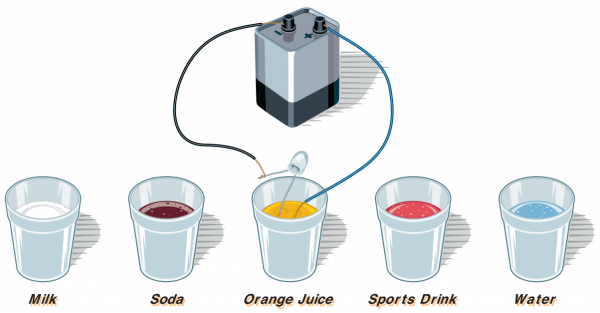Keep Your Ion the Ball Experiment
Background
Did you ever wonder why your sweat and tears taste salty? It’s because the water that makes up 60–70 percent of your body has salts dissolved in it. These salts—which include compounds of sodium, potassium, magnesium, and calcium—are necessary for good health. A loss of electrolytes, called an electrolyte imbalance, can slow down the transmission of nerve impulses, impair muscle function, and cause an irregular heartbeat.
Your body loses electrolytes when you sweat. Normally you get all the electrolytes you need from the food you eat. (Bananas and potatoes, for example, contain a lot of potassium.) Because they sweat a great deal, professional and endurance athletes can lose a large quantity of electrolytes during practice and competition. They will often turn to sports drinks to quickly restore the balance. That’s because sports drinks contain a lot of sodium and potassium.
In this experiment you will test the conductivity (ability to conduct electricity) of a variety of beverages to see which ones contain a higher concentration of electrolytes. The beverage that has the highest concentration of electrolytes will have the greatest conductivity.
Materials
- 6-volt battery
- two 8-inch pieces of coated wire (18-22 gauge) with ends stripped
- wire cutters
- electrical tape
- one jumbo super-bright LED (light-emitting diode) bulb
- at least three beverages to test
- paper cups, one for each beverage

Steps
- Set up the equipment as shown. Make sure the shorter lead of the LED is connected to the wire leading to the negative terminal of the battery and the longer lead is left unconnected. Use electrical tape to secure the connections.
- Predict which beverage has the most electrolytes, and which has the least. Why do you think so?
- Test each beverage by dipping both the long lead of the LED and the tip of the loose wire into the liquid. Note whether the LED lights up and, if so, how bright it is. The brighter the light, the better the beverage conducts electricity and the more electrolytes it contains. (Important: Because the LED may appear brighter or dimmer depending on the angle at which you view it, be sure to view the LED from the same angle each time. In addition, clean off the LED lead and wire tip between each test.)
- Which beverages have a higher concentration of electrolytes? How do you know?
- Which beverages have a higher concentration of electrolytes? How do you know?
- Which beverages have a lower concentration? How do you know?
- How were the results different from your prediction?

